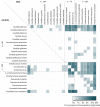Candida species and selected behavioral factors co-associated with severe early childhood caries: Case-control study
- PMID: 35959372
- PMCID: PMC9357982
- DOI: 10.3389/fcimb.2022.943480
Candida species and selected behavioral factors co-associated with severe early childhood caries: Case-control study
Abstract
Severe Early Childhood Caries (sECC) is a multifactorial disease associated with the occurrence of specific oral microorganisms and other environmental, behavioral, and genetic factors. This study aimed to construct a multivariable model including the occurrence of Candida spp. and selected behavioral factors (length of breastfeeding, serving sweet beverages and beginning of brushing child's teeth) to determine their relationships to the occurrence of sECC. In this case-control study 164 children with sECC and 147 children without dental caries were included. MALDI-TOF MS and multiplex qPCR were used to identify Candida spp. and selected bacteria in dental plaque samples, respectively. A questionnaire on oral hygiene, diet, and children's health was filled in by the parents. The constructed multivariable logistic regression model showed an independent influence of the microbial and behavioral factors in sECC etiopathogenesis. The occurrence of C. albicans and C. dubliniensis was associated with higher odds of sECC development (odds ratio, OR: 9.62 and 16.93, respectively), together with breastfeeding of 6 months or less (OR: 2.71), exposure to sweet beverages (OR: 3.77), and starting to brush child's teeth after the 12th month of age (OR: 4.10), all statistically significant (p < 0.01). Considering the high occurrence of C. albicans and C. dubliniensis in dental plaque in children with sECC, we propose them as "keystone pathogens" and risk factors for sECC. The models showed that presence of specific species of Candida in dental plaque may be a better descriptor of sECC than the mentioned behavioral factors.
Keywords: Candida dubliniensis; Candida sp.; Streptococcus mutans; breastfeeding; brushing of teeth; severe early childhood caries (sECC); sweet beverages.
Copyright © 2022 Cvanova, Ruzicka, Kukletova, Lipovy, Gachova, Izakovicova Holla, Danek, Hola, Bartosova, Jarkovsky, Dusek and Borilova Linhartova.
Conflict of interest statement
The authors declare that the research was conducted in the absence of any commercial or financial relationships that could be construed as a potential conflict of interest.
Figures




Similar articles
-
Presence of mutans streptococci and Candida spp. in dental plaque/dentine of carious teeth and early childhood caries.Arch Oral Biol. 2006 Nov;51(11):1024-8. doi: 10.1016/j.archoralbio.2006.06.001. Epub 2006 Aug 7. Arch Oral Biol. 2006. PMID: 16890907
-
Prevalence of Candida albicans and Candida dubliniensis in caries-free and caries-active children in relation to the oral microbiota-a clinical study.Clin Oral Investig. 2016 Nov;20(8):1963-1971. doi: 10.1007/s00784-015-1696-9. Epub 2015 Dec 23. Clin Oral Investig. 2016. PMID: 26696116
-
Streptococcus mutans-associated bacteria in dental plaque of severe early childhood caries.J Oral Microbiol. 2022 Mar 2;14(1):2046309. doi: 10.1080/20002297.2022.2046309. eCollection 2022. J Oral Microbiol. 2022. PMID: 35251525 Free PMC article.
-
A comparative study of Streptococcus mutans and lactobacilli in mothers and children with severe early childhood caries (SECC) versus a caries free group of children and their corresponding mothers.J Clin Pediatr Dent. 2006 Winter;31(2):80-5. doi: 10.17796/jcpd.31.2.w8555245202l6761. J Clin Pediatr Dent. 2006. PMID: 17315799
-
Roles of Streptococcus mutans-Candida albicans interaction in early childhood caries: a literature review.Front Cell Infect Microbiol. 2023 May 16;13:1151532. doi: 10.3389/fcimb.2023.1151532. eCollection 2023. Front Cell Infect Microbiol. 2023. PMID: 37260705 Free PMC article. Review.
Cited by
-
Unveiling the complexity of early childhood caries: Candida albicans and Streptococcus mutans cooperative strategies in carbohydrate metabolism and virulence.J Oral Microbiol. 2024 Apr 10;16(1):2339161. doi: 10.1080/20002297.2024.2339161. eCollection 2024. J Oral Microbiol. 2024. PMID: 38606339 Free PMC article. Review.
-
The value of parotid sialography in the diagnosis and staging of Sjogren's syndrome.J Dent Sci. 2024 Oct;19(4):2179-2185. doi: 10.1016/j.jds.2024.03.007. Epub 2024 Mar 19. J Dent Sci. 2024. PMID: 39347041 Free PMC article.
-
Presence of candida in the dental plaque and saliva of patients with severe early childhood caries and early childhood caries:a pilot study.Eur Oral Res. 2024 May 5;58(2):102-107. doi: 10.26650/eor.20241067980. Eur Oral Res. 2024. PMID: 39011175 Free PMC article.
-
Association of Breastfeeding and Early Childhood Caries: A Systematic Review and Meta-Analysis.Nutrients. 2024 Apr 30;16(9):1355. doi: 10.3390/nu16091355. Nutrients. 2024. PMID: 38732602 Free PMC article. Review.
References
-
- Al-Ahmad A., Auschill T. M., Dakhel R., Wittmer A., Pelz K., Heumann C., et al. . (2016). Prevalence of Candida albicans and Candida dubliniensis in caries-free and caries-active children in relation to the oral microbiota-a clinical study. Clin. Oral. Investig. 20, 1963–1971. doi: 10.1007/s00784-015-1696-9 - DOI - PubMed
-
- American Academy of Pediatric Dentistry (2017) Policy on early childhood caries (ECC): classifications, consequences, and preventive strategies. Available at: https://www.aapd.org/research/oral-health-policies–recommendations/early... (Accessed May 7, 2022). - PubMed
Publication types
MeSH terms
Supplementary concepts
LinkOut - more resources
Full Text Sources
Medical
Miscellaneous

